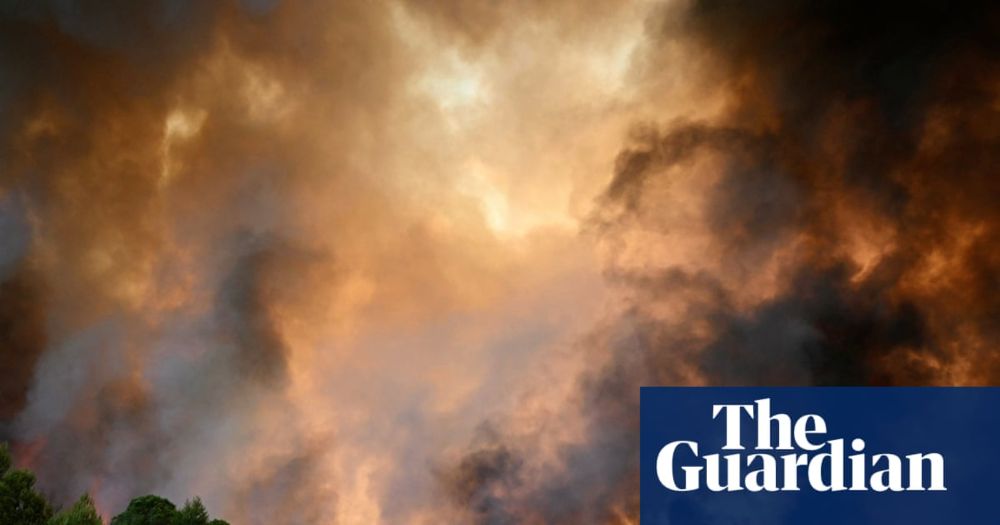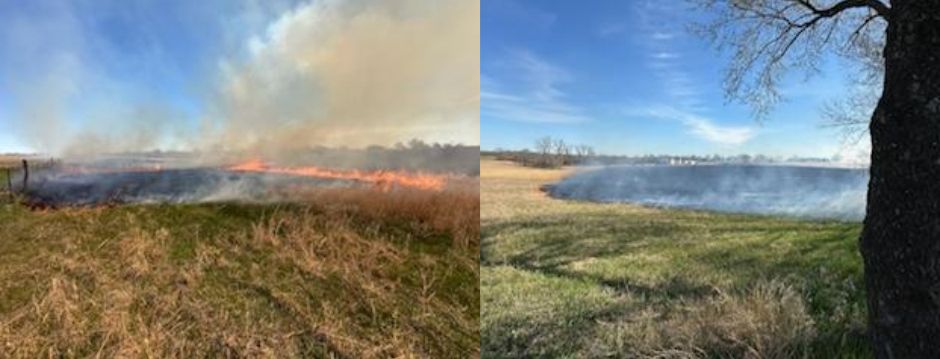Redirecting...
This is a great job if you have the right skills. I am looking at you archaeometry-types. www.facebook.com/share/1PXdkz...
21.08.2025 21:32 — 👍 0 🔁 0 💬 0 📌 0
PNAS
Proceedings of the National Academy of Sciences (PNAS), a peer reviewed journal of the National Academy of Sciences (NAS) - an authoritative source of high-impact, original research that broadly spans...
Roos et al. have managed to find information where it was thought implausible…[in] this seminal publication. We have a lot of fire in our future. But then we have had a lot of fire for all of our past. It is there to learn from if we choose to look for it.
www.pnas.org/doi/10.1073/...
19.08.2025 15:01 — 👍 2 🔁 0 💬 1 📌 0

A 1940 Western Apache (Ndee) farm site with two wickiups in a ponderosa pine forest.
CREDIT: Lee Russell/Library of Congress
Tree-ring fire records from 649 pine trees in central and eastern Arizona show that fires occurred more often in the territory of the Western Apache, or Ndee, than in other regions between 1600–1870, suggesting a culturally controlled fire regime. In PNAS: www.pnas.org/doi/10.1073/...
18.08.2025 20:58 — 👍 34 🔁 15 💬 0 📌 0
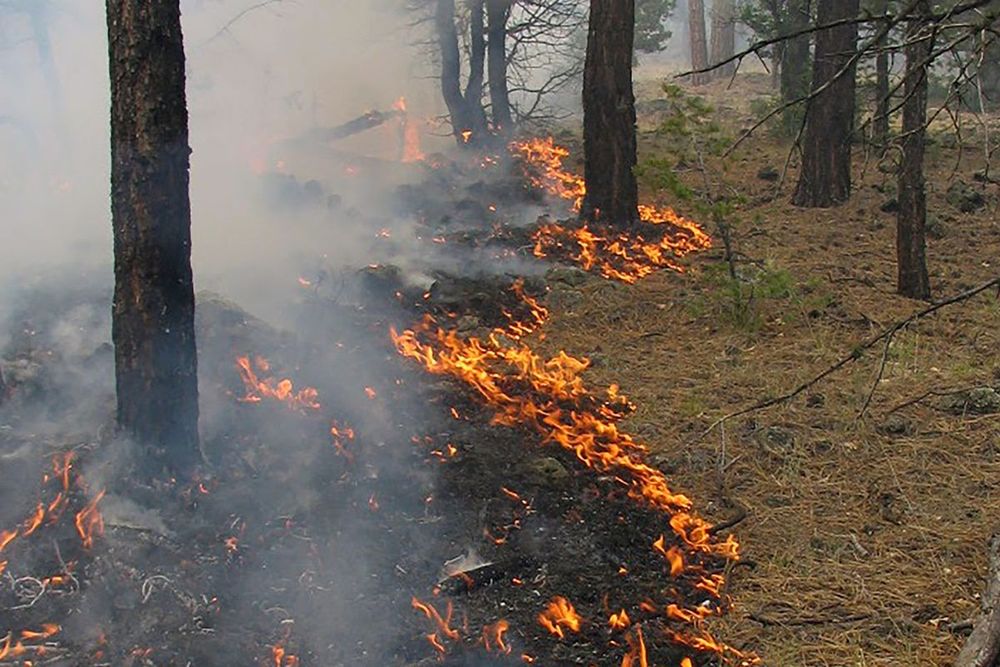
New research on fire-scarred trees reveals Western Apache communities had far greater control over landscape fire patterns than scientists previously thought possible. Picture of wildfire in forest.
A new study led by SMU fire scientist Christopher Roos reveals that Western Apache communities had far greater control over fire patterns across Arizona than scientists previously believed possible. 🧪🌎 www.smu.edu/news/researc...
07.08.2025 16:44 — 👍 7 🔁 4 💬 0 📌 0
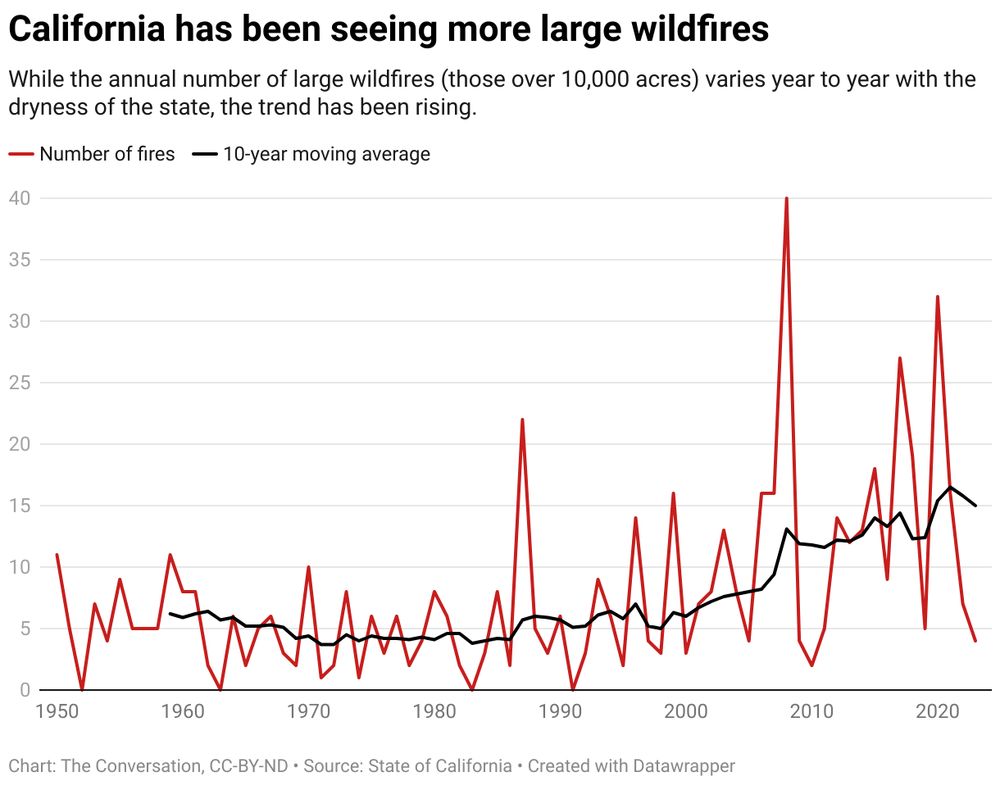
Chart with header: California has been seeing more large wildfires
While the annual number of large wildfires (those over 10,000 acres) varies year to year with the dryness of the state, the trend has been rising.
The chart shows a spiky line from 1950 to 2020, with big spikes in the past 15 years and an accelerating upward 10-year moving average
#Wildfire season is starting weeks earlier in California (up to 2.5 months in some mountainous regions) and large fires have grown more frequent, according to a new analysis of 30 years of fire data. Hotter temperatures and dryer atmospheric conditions are responsible buff.ly/zlitNPA #ClimateSky
06.08.2025 19:48 — 👍 10 🔁 9 💬 3 📌 1
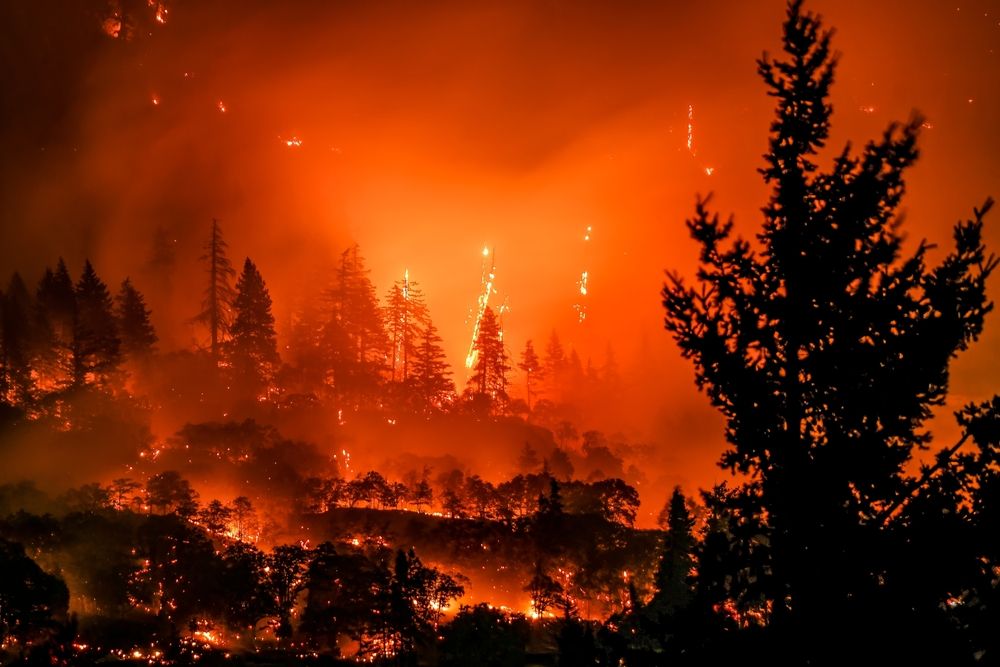
Tunnel 5 Fire in the Columbia River Gorge, Washington, July 2023.
Wildfire activity worldwide was higher in 2023 and 2024 than in any year since monitoring began in 2001. Tropical forests are seeing particularly high rates of forest loss. Some forest systems may be approaching tipping points of ecosystem change. In PNAS: www.pnas.org/doi/10.1073/...
06.08.2025 20:22 — 👍 5 🔁 3 💬 0 📌 0

Tree rings reveal persistent Western Apache (Ndee) fire stewardship and niche construction in the American Southwest | PNAS
Identifying the influence of low-density Indigenous populations in paleofire records
has been methodologically challenging. In the Southwest United...
Fine work that both extends our knowledge of the past and has implications for today. Ndee (Western Apache) land management did a remarkable job controlling forest fires, even in drought-heavy eras like ours. It defies belief to think today's fire-torn SW has nothing to learn from those guys.
05.08.2025 15:09 — 👍 49 🔁 15 💬 1 📌 0

6/Tree-rings reveal that these patterns persisted for centuries. We need to learn more from Indigenous knowledge and experience built over centuries to millennia to better understand our current wildfire problems and how we can get out of them.
05.08.2025 13:29 — 👍 2 🔁 0 💬 0 📌 0

5/Altogether, this meant that climate had much less influence on fire patterns within Ndee landscapes than in the rest of the region.
05.08.2025 13:29 — 👍 0 🔁 0 💬 1 📌 0

4/And based on within-ring fire-scar positioning, there was a bias towards greater fire occurrence in late April or May (early earlywood scars), which is when Western Apache (Ndee) people moved back into pine forests each year as part of their seasonal mobility patterns.
05.08.2025 13:29 — 👍 0 🔁 0 💬 1 📌 0

3/And by looking at ratios of the fire return intervals of widespread vs. all fires, we were able to show that fires were overwhelmingly small compared to the rest of the region.
05.08.2025 13:29 — 👍 0 🔁 0 💬 1 📌 0

2/Using 649 tree-ring samples from across ~48,800 km2 of Western Apache homelands, we show that mean fire intervals were unusually short in Apacheria compared to 3,880 tree-ring samples from across Arizona and New Mexico outside of Apacheria. All samples from dry conifer forests.
05.08.2025 13:29 — 👍 0 🔁 0 💬 1 📌 0
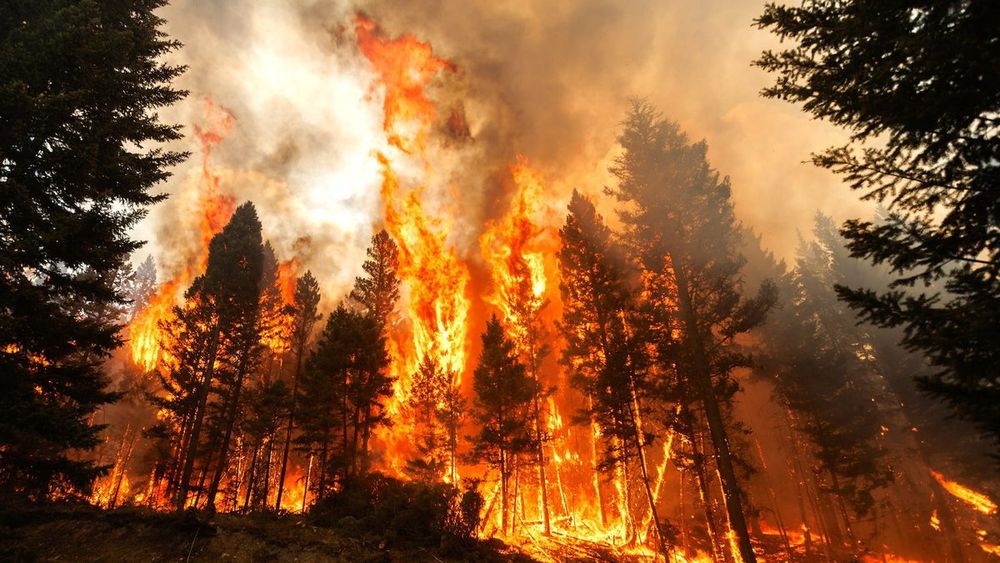
On Controlling Fire, New Lessons from a Deep Indigenous Past
For centuries, the Native people of North America used controlled burns to manage the continent's forests. In an e360 interview, ecologist Lori Daniels talks about the long history of Indigenous burni...
“There’s a school of thought that you can just put a fence around a forest and keep people out, and it will be protected, which is a very old-school view, a very colonial view. It comes from this idea that we came to a land that was ‘empty’ and there for the taking.”
26.07.2025 14:42 — 👍 35 🔁 16 💬 2 📌 2
I'm back home with my dad and have thoughts about being an Indigenous scientist and academic. I'm writing this in real time so it might get disrupted and will have typos.
I am fairly successful by academic standards. I have a tenure track job, wrote papers, have grant funding, mentor students.
21.07.2025 21:18 — 👍 381 🔁 107 💬 3 📌 8
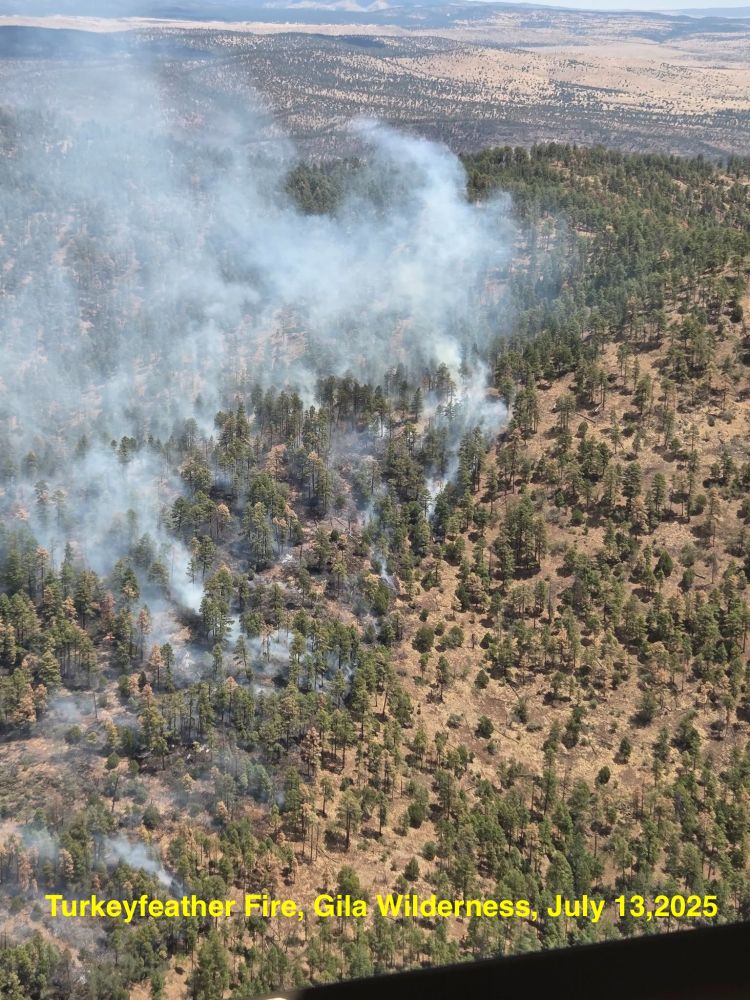
low severity surface fire burning through a ponderosa pine forest
The Turkeyfeather Fire in the Gila Wilderness, NM has burned as a low-severity fire over about 24,000 acres (so far). This is a continuation of a fire regime that existed for millennia before the 20th century. This 🧵reviews the fire history of the Gila, as my colleagues and I have studied it. 1/18
20.07.2025 13:35 — 👍 67 🔁 26 💬 2 📌 8
Media Relations Manager | Science & Technology at #SMU
https://www.smu.edu/news/research
Sharing discoveries from Dallas, Texas
PhD student
Archaeologist researching the US Southwest, and museum professional.
Archaeologist, US Southwest, medieval Peloponnese, willing to grill in subzero weather.
The ClimateChangePost: the latest news on how the shifting climate is affecting life in Europe. https://www.climatechangepost.com
Historian of environment/climate/cities/culture. SLC via AL and LA; UCLA Bruin. Book: The Frontier of Leisure: SoCal and the Shaping of Modern America; currently writing a book about climate and history in the US and North America.
Geographer at U Nevada, Reno. Interested in past and present climate, dendrochronology, forest health, environmental history, and the Arctic. 🇨🇦 (he/him). views my own.
Professor, archaeologist, sometime historian, interested in all things California and Baja California. Former A's fan. Views my own.
Exploring the ecology of an increasingly human planet.
Prof. Geography & Environmental Systems, UMBC
Anthromes, Anthroecology & Anthropocene
https://anthroecology.org/people/ellis/
CRM archaeologist/geoarchaeologist/geoscience PhD candidate
@BaylorGeo. Molecular fossils + stable isotopes. Not one to post.
The combined research labs of Drs. Jacob and Isabelle Holland-Lulewicz at Penn State Anthropology. The Spatial Archaeology and Historical Network Dynamics Lab (SAHND) and the Laboratory for Socioecological Histories of Estuarine Landscapes (SHEL)
A journal covering natural, social, engineering and technology fields about sustainability, its policy dimensions and viable solutions.
Part of Nature Portfolio.
https://www.nature.com/natsustain/
Journal of the International Association of Wildland Fire
Publishing fundamental & applied fire research, including fire modelling, management, ecological & societal impacts.
https://www.publish.csiro.au/wf
Explore groundbreaking news and research from PNAS, one of the world's most-cited scientific journals. Discover its sibling journal, @pnasnexus.org, both official journals of the National Academy of Sciences. Visit www.pnas.org for more info.
An open access @natureportfolio.bsky.social journal publishing high quality primary research, reviews, and commentary in Earth, environmental, and planetary science.
nature.com/commsenv/
Nature Ecology & Evolution publishes research and comment across the entire breadth of ecology and evolution, including both pure and applied topics. nature.com/natecolevol
UTA > UNTHSC (MSc) > Max Planck SHH (PhD) > Institut Pasteur Postdoc > SMU Assistant Prof and director of the Modern and Ancient Microbial Genomics labs.
Climate scientist studying drought, land surface processes, climate extremes. https://www.drbenjamincook.net/
Research Associate Professor @UArizona tysonswetnam.com
Director of Open Science, Institute for Computation and Data Enabled Insight
Co-Principal Investigator cyverse.org
climate scientist
posts 100% my own
🇨🇦 is my home
distinguished professor & chair, Texas Tech
chief scientist, The Nature Conservancy
board member, Smithsonian NMNH
alum, UToronto and UIUC
author, Saving Us
Researches pyroecophysiology, fire ecology, remote sensing, fire social science, lidar, and anything else that interests me. Prof and Chair - Earth and Spatial Sciences - College of Science - University of Idaho






